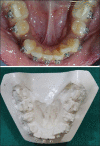Comparison of two different initial archwires for tooth alignment during fixed orthodontic treatment-A randomized clinical trial
- PMID: 34568209
- PMCID: PMC8423150
- DOI: 10.4103/jos.JOS_17_20
Comparison of two different initial archwires for tooth alignment during fixed orthodontic treatment-A randomized clinical trial
Abstract
Objectives: The aim of the study was to clinically evaluate and compare 0.016-inch superelastic nickel-titanium (NiTi) and 0.016-inch heat-activated nickel-titanium (NiTi) archwires in terms of alignment efficiency, root resorption, and pain intensity.
Method: A total of 20 patients requiring fixed orthodontic treatment, having Little's irregularity index of 5-8, and requiring first premolar extractions were recruited. They were randomly allocated to receive two different archwires (0.016-inch superelastic NiTi or 0.016-inch thermoelastic NiTi). Good-quality impressions were taken of the lower arch before archwire placement (T0) and at every month after that till the alignment was complete. The rate of tooth alignment was measured on casts by determining Little's irregularity index. The pain experienced by the patient was assessed 24 hours and 1 week after the placement of the archwire on a visual analogue scale. Cone beam computed tomographic radiographs of lower anterior teeth were taken before and after alignment to assess root resorption. Data obtained were subjected to statistical analysis using the SPSS software (version 20.0). The level of significance was kept at 5%.
Results: The repeated measures ANOVA indicated that there was no significant difference in the aligning efficiency of superelastic and heat-activated NiTi wires. (p = 0.45). The Mann Whitney U test showed that superelastic NiTi wires had statistically significant higher VAS scores than heat-activated NiTi at 24 hours and 1-week interval (p < 0.05). Student's t-test indicated greater root resorption with superelastic NiTi but the difference was not statistically significant.
Conclusion: Both the wires showed similar aligning efficiency and resulting root resorption. Superelastic NiTi was observed to produce more pain compared to heat-activated NiTi in the aligning phase.
Keywords: Arch wire; alignment; root resorption.
Copyright: © 2021 Journal of Orthodontic Science.
Conflict of interest statement
There are no conflicts of interest.
Figures






References
-
- Proffit WR. St Louis: CV Mosby Cooperation; 2000. Contemporary Orthodontics.
-
- West AE, Jones ML, Newcombe RG. Multiflex versus superelastic: A randomized clinical trial of tooth alignment ability of initial arch wires. Am J Orthod Dentofacial Orthop. 1995;108:464–71. - PubMed
-
- Pandis N, Polychronopoulou A, Eliades T. Alleviation of mandibular anterior crowding with copper-nickel-titanium vs nickel-titanium wires: A double-blind randomized control trial. Am J Orthod Dentofacial Orthop. 2009;136:152–3. - PubMed
-
- Gravina MA, Brunharo IH, Fraga MR, Artese F, Campos MJ, Vitral RW, et al. Clinical evaluation of dental alignment and leveling with three different types of orthodontic wires. Dent Press J Orthod. 2013;18:31–7. - PubMed
-
- Papageorgiou SN, Konstantinidis I, Papadopoulou K, Jäger A, Bourauel C. A systematic review and metaanalysis of experimental clinical evidence on initial aligning archwires and archwire sequences. Orthod Craniofac Res. 2014;17:197–215. - PubMed
LinkOut - more resources
Full Text Sources
